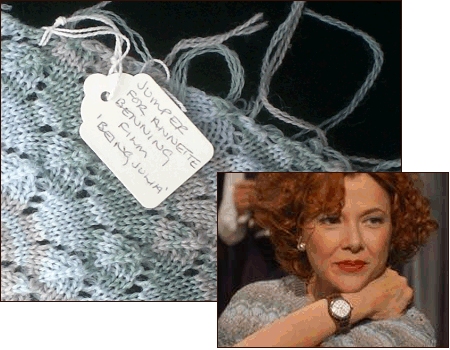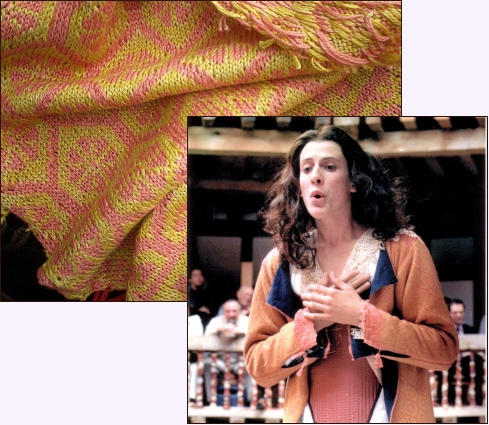For many knitters, looking through a bag of swatches from previously knit items is like a trip down memory lane. A snippet of lace may evoke the christening blanket knit for a first grandchild; a brightly colored bit of ribbing suggests the socks knit while on vacation; a scrap of stranded knitting calls to mind the epic Fair Isle sweater project that took months to complete. At first glance Gina Pinnock’s collection of knitting swatches looks much the same as any other. However, while it does contain many four-inch squares of meticulously labeled, brightly colored knitted fabric, there the resemblance to “normal” knitting swatches ends. The labels on the swatches tell their own unique story.

“Jumper for Annette Benning – Being Julia”, reads the tag on a swatch of scalloped lace, knit in variegated pastels. A beautiful chevron lace, knit in an impossibly fine gauge, sports a label reading, “Vest for Rachel Weiss – The Mummy Returns”. Sparkly Lurex yarns, in shades of blue and violet that could only be fit for a fairy, actually are, as the label informs us the swatch is for a “Blue Fairy Bolero – Pinocchio – Royal Opera House Ballet”.
A knitwear designer specializing in costume design for television, film and the theater, Gina Pinnock has knit stockings for Holly Hunter, an Aran wedding dress for Heather Graham, and a pair of silk long johns for Harvey Keitel. You won’t see her on the red carpet at Oscar time, however, and you won’t even find her name in the credits of most of the films on which she’s worked. An unsung hero working backstage and behind the silver screen, Gina quickly and quietly designs knitwear for the stars.
From her studio in a co-op warehouse building, where she worked for nearly twenty years, Gina knit costumes for a demanding industry, just a stone’s throw away from the Thames, in central London. Though she’s now traded the bustle of London for the slower pace of life in rural Cornwall, she continues to work as part of an elite cadre of specialty knitwear designers in Britain.
Her career began with a degree in Textiles from West Sussex College of Design, where she focused on fashion knitwear. Many of her friends studied theatre Arts, however, so she wound up spending a lot of time in that department as well. Although she had thought she was preparing for a career in fashion, looking back she can see the path that led her to costume design. “With hindsight I can really see that I’ve ended up in the place I should be, although I didn’t actually set out to get here,” she says.
Before finding her true calling in costuming, however, Gina trod the path of many starry-eyed designers and launched her own collection of knitwear. Competing in this challenging oftentimes-cutthroat industry, she found the demands of wearing so many hats – as designer, maker and marketer of her collections – exhausting and, she says, “Thankless”.
In a scene reminiscent of old Hollywood, Gina’s first break happened during a chance meeting at a dinner party, and a lengthy conversation with someone who just happened to be a costume designer for television. She barely remembers her first television commission, momentous though it might have been. At the time it was just a “quickie” project, produced on a tight deadline, for which she was paid well. Her television work soon led to larger commissions, however, as her name began to be known in the trade. With her foot now firmly planted in the door of an industry notoriously hard to break into, Gina went on to design for film and, eventually, the London stage.
Her most challenging project to date has been an Elizabethan-style jacket, knit for Shakespeare’s Globe Theater production of Julius Caesar, in 2003. Designed for the character “Portia”, the fabric of the jacket was patterned after a period brocade jacket, circa 1697, that Gina unearthed at the Victoria and Albert Museum, in London. Wool for Portia’s jacket was hand-dyed, using only natural dyes that would have been available at the time. Knit in an intricate two-color fair isle, by both hand and machine, the jacket is now a part of the permanent collection in the Museum of the Globe Theater.

Gina’s talent for research and design of period costumes is also much in demand from such venerable institutions as the BBC, the Royal Opera Company, and The Old Vic, where authenticity is of primary concern. This penchant for getting the details of period costumes just right brought Gina’s work to the notice of costume curators for the Victoria and Albert Museum in London. While researching Elizabethan brocade patterns for Portia’s jacket, she received a commission to knit a pair of silk stockings for the Charles II mannequin at the V&A.
“This is how it happens in this business,” she says. “If you can get a foot in the door, you’ll have more work than you sometimes can handle. It’s just getting that first commission that’s the hard part.”
The hardest part of her job, besides working to extremely tight deadlines, and what Gina calls “the ridiculous hours”, is that very often much of her hard work and skill wind up on the cutting room floor. After knitting countless pairs of silk stockings for the film Elizabeth, starring Kate Blanchett, Gina sat through the entire film, watching waiting for a glimpse of silk-clad ankle to appear from beneath the voluminous skirts of the actors. It never happened. “All those hours of work,” she mourns, “and there wasn’t a single stocking in sight.”
Gina’s tales of the long nights, and tight deadlines, the costumes that never get seen and the demanding directors that are the norm for this kind of work, quickly strip away any illusions of romance about her chosen career. “It’s a good job,” she says, “But physically demanding, and like most other forms of freelance employment there are plenty of pitfalls.” She paints a pragmatic, rather than rosy picture of her work. However, among her carefully labeled swatches, one rather plain one stands out, the label of which is enough to put the stars back in any aspiring costume designer’s eyes. It reads: Captain Corelli’s Mandolin – Sweater for Nicholas Cage.


I am in awe!
This is so neat! Why isn’t she named in the credits? That kind of work totally deserves a name mention. Thanks for sharing it with us, Brenda.
How cool is that! No kidding, even with the hours and the things that are cut away… to be able to know that Nicolas Cage has worn a sweater from your hand… sigh!
I agree with Emily that she should really be in the credits! She MUST be! Her work is a great part of the presentation!
Thank you for sharing this. It was enlightening and very inspirering!
I am jealous, this woman combines many of the things I always wanted to do in life, and I’ve always loved that vest that Rachel Weiss wears, I never thought of it as being a one-off handknit. Thanks for sharing Brenda, and the new site is superb!
Her work is amazing and as far as I’m concerned, she is entitled to having her name in the credits. I find it kind of appalling that she’s not included when she does such high detail, meticulous work!
And I have to admit, I, along with others, am just a teensy weensy bit jealous.
Wow — what a great article. Amazing work, and a dedicated craftswoman!
Excellent article. Gina has my fantasy job: getting paid to knit beautiful things.
What an amazing job which requires an exacting research of history and skill. Thank you for bringing this story to knitters everywhere. I have long admired many of the knits I see in films and have often wondered where they find the garments and accessories.
Thanks, Brenda, for a terrific article. I agree with everyone else: Gina Pinnock’s name should be in the credits.
Great article! Excellent writing, gripping content. Well done!
I always check out the knits in movies and I loved your article. Do you have any way of finding out who designed the scarf/shoulder thingy worn by Nicole Kidman in the remake of The Stepford Wives? There is a picture here: http://movies.yahoo.com/movie/1808411987/photo/531854
I’ve been wanting to try a knock off ever since I saw the movie, but haven’t gotten around to it yet.
Thanks for all you do. I love the new website and all the great info in it. I hoard your podcasts and just finished listening to number 71. I’ve been a listener since your first issue – Happy Anniversary!
By the jacket for Portia, I was swooning, actually swooning. Lovely. Thank you.
Thank-you for this article.
I’ve worked on a local indie film and volunteered in the Detroit Opera House costume department. Sadly, I’m not the fastest knitter, but want to find some way to translate this love for yarn into something full-time. This inspires me.
I’m shocked that Gina Pinnock’s name does not get mentioned in the end titles. I’m pretty sure I’ve seen credits for ‘Plasterer’ and ‘Truck Driver’…sure they’re important-ish but how many times is one mesmerised by a particular costume days, months and years after seeing a film!!! I remembered N Cage’s jumper enough to Google it and find this blog! Go Gina!